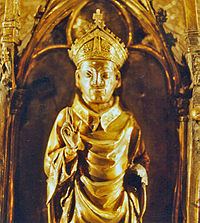- Ancient Diocese of Embrun
-
The former French Catholic archdiocese of Embrun was suppressed after the French Revolution. Its see was Embrun Cathedral.
It had as suffragans the diocese of Digne, diocese of Antibes and Grasse, diocese of Vence, diocese of Glandèves, diocese of Senez and diocese of Nice.
Contents
History
Tradition ascribes the evangelization of Embrun to Saints Nazarius and Celsus, martyrs under emperor Nero.
The first bishop was St. Marcellinus (354-74).
Other bishops of Embrun were St. Albinus (400-37); St. Palladius (first half of the sixth century); St. Eutherius (middle of the seventh century); St. James (eighth century); St. Alphonsus (eighth century); St. Marcellus (end of the eighth century), whom Charlemagne sent to evangelize Saxony; St. Bernard (805-25), under whose episcopate Charlemagne enriched the diocese of Embrun; St. Benedict (beginning of the tenth century), martyred by the Saracen invaders; St. Liberalis (920-40); St. Hismide (1027-45); St. Guillaume (1120-34), founder of the celebrated Abbey of Boscodon; St. Bernard Chabert (1213-35), Blessed Henry of Segusio (1250-71), known as (H)Ostiensis, i.e. Cardinal Bishop of Ostia, an orator and canonist of renown; the Dominican Raimond of Mévolhon (1289-94), who defended the doctrine of Thomas Aquinas against the English theologians; Bertrand of Deaux (1323-38), who as the legate of Clement VI at Rome did much to bring about the downfall of Rienzi; Jacques Gelu (1427-32), one of the first prelates to recognize the supernatural vocation of Joan of Arc; Giulio de' Medici (1510-11), later pope under the name of Clement VII; Cardinal François de Tournon (1517-26), employed on diplomatic missions by king Francis I of France, and founder of the College de Tournon; Cardinal de Tencin (1724-40), who in September, 1727, caused the condemnation by the Council of Embrun of the Jansenist Soanen, Bishop of his suffragan see of Senez.
St. Vincent Ferrer preached several missions against the Vaudois in the Diocese of Embrun.
Besides the bishops named the following are honored as saints in the present Diocese of Gap: Vincent, Orontius and Victor, martyrs in Spain in the fourth century, the anchorite Veranus (sixth century), afterwards Bishop of Cavaillon, and the anchorite St. Donatus (sixth century).
When the diocese of Gap was re-established in 1822 it comprised, besides the ancient Diocese of Gap, a large part of the ancient archdiocese of Embrun. The name of this last metropolitan see, however, had been absorbed in the title of the Archbishop of Aix until 2007. In 2008, the title was reattached to the diocese of Gap by the pope.[1]
Bishops
- † c.374: Saint Marcellin
- 374: Artemius
- c.400: Saint Jakob I.
- 439: Armentaire
- 441 to c.475: Ingenuus
- 517: Catulin
- Gallicanus I
- Saint Palladius
- c.541 to c.549: Gallicanus II
- c.567: Saloine
- c.585 to c.588: Emerite
- 614: Lopacharus
- c.630: Saint Albin
- c.650 to c.653: Ætherius
- c.740: Vualchinus
- c.791–794: Marcellus
Archbishops
- Bernardus
- 829: Agéric
- c.853 to c.859: Aribert I.
- 876: Bermond
- 878: Aribert II.
- 886: Ermold
- 899: Arnaud
- 900–916: Saint Benedict I.
- 920: Saint Liberalis of Embrun (Liberal)
- 943–960: Boson
- c.970: Amédée
- 992: Ponce
- 1007–1010: Ismidias
- c.1016 to c.1027: Radon
- c.1033–1044: Hismidon
- c.1048: Vivemne
- 1050–1054: Guinervinaire
- 1054–1055: Hugues
- 1055–1065: Viminien or Guinamand
- 1066–1077: Wilhelm I.
- 1077: Peter I.
- c.1080–1084: Lantelme
- 1105–1118: Benedict II.
- 1120–1134: Guillaume II.
- 1135 to 7 December 1169: Guillaume III. de Benevent
- 9 January 1170 to 1176: Raimond I.
- c.1177–1189: Pierre II. Romain
- 1189–1208: Guillaume IV. de Benevent
- 1208 to c.1212: Raimond II. Sédu
- 1212 to c.1235: Bernard I. Chabert
- 1236 to 23. May 1245: Aimar
- 1246–1250: Humbert
- 1250 to 6. November 1261: Henri de Suse
- 1267–1275: Melchior
- 1275–1286: Jacques II. Sérène
- 4 August 1286 to 1289: Guillaume V.
- 8 October 1289 to 28 June 1294: Raimond de Médullion
- 28 March 1295 to 1311: Guillaume VI. de Mandagot
- 22 May 1311 to 1317: Jean I. du Puy
- 1319 to c.1323: Raimond IV. Robaud
- 5 September 1323 to 1338: Bertrand I. de Deaulx
- 27. January 1338 to 17. December 1350: Pasteur de Sarrats
- 16. February 1351 to 1361 or 1363: Guillaume VII. de Bordes
- 1363–1364: Raimond V. de Salg
- 8 January 1364 to 5. September 1365: Bertrand II. de Castelnau
- 1365–1366: Bernard II.
- 1366 to 18 December 1378: Pierre III. Ameil
- 1379 to 1 May 1427: Michel Etienne
- 1427 to 7 September 1432: Jacques III. Gelu
- 1432 to 17 January 1457: Jean II. Girard
- 1457 to c.1470: Jean III de Montmagny
- c.1470–1494: Jean IV. Baile
- 1494–1510: Rostaing d'Ancezune
- 1510–1511: Giulio di Giuliano de' Medici
- 1511–1516: Nicolas de Fiesque (Fieschi), Cardinal
- 1517–1525: François de Tournon
- 1526–1551: Antoine de Lévis de Château-Morand
- 1551–1555: Balthasar de Jarente
- 1555: Louis de Laval de Bois-Dauphin
- 1556–1560: Robert Cardinal de Lenoncourt
- 1561–1600: William of Avançon de Saint-Marcel, Cardinal de Embrun
- 1601–1612: Honoré du Laurens
- 1612–1648: Guillaume d'Hugues
- 1649–1668: Georges d'Aubusson de La Feuillade
- 1668–1714: Charles Brûlart de Genlis
- 1715–1719: François-Elie de Voyer de Paulmy d'Argenson
- 1719–1724: Jean-François-Gabriel de Hénin-Liétard
- 1724–1740: Pierre Guérin de Tencin (also Archbishop of Lyon)
- 1741–1767: Bernardin-François Fouquet
- 1767–1790: Pierre-Louis de Leyssin
- 1791–1793: Ignace Caseneuve
References
External links
 This article incorporates text from a publication now in the public domain: Herbermann, Charles, ed (1913). Catholic Encyclopedia. Robert Appleton Company.Categories:
This article incorporates text from a publication now in the public domain: Herbermann, Charles, ed (1913). Catholic Encyclopedia. Robert Appleton Company.Categories:- Bishops of Embrun
- Former Roman Catholic dioceses in France
- Dioceses established in the 4th century
Wikimedia Foundation. 2010.

